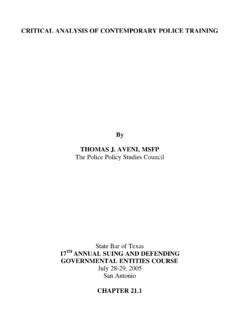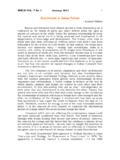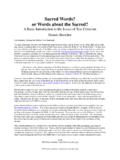Transcription of The Force Continuum Conundrum - Police Deadly …
1 The Force Continuum Conundrum By Thomas J. Aveni, There seems to be a nature intrinsic in man to run with what might have originally been a good idea, far beyond its practical limitations. If you ll excuse the metaphor, we tend to run a good horse until it s lame or worse. An example of this tendency can be found in the application of so-called Force continuums. Purpose of Force Continuums Force continuums have been evolving in the law enforcement community for more than three decades. These devices were, and remain for the most part, conceptualization tools. We use them as a sort of graphical user interface for unraveling the complex and inflammatory realm in which Police are tasked with using Force with requisite objective reasonableness.
2 They almost universally reflect a logical and reasonable progression of Force response to what are usually illogical manifestations of non-compliant and/or aggressive behavior. As conceptualization tools, Force continuums have always had their shortcomings. Some of these difficulties may be attributed to the very nature of the shifting nature of law and the public perception of policing. These devices have been hampered (if not cursed) by attempting to create a black-&-white menu of options from a world of grey facts and circumstances. This issue is further exacerbated by many unreasonable expectations that we ve placed in their usage. Emerging Concern One emerging trend that administrators and trainers should find particularly alarming is that of employing Force continuums in lieu of written use of Force policy.
3 The rationale behind this trend seems be that officers will comprehend a graphical representation of agency policy more effectively than what they will when that same policy is expressed in a text format. Is there truth in that premise? Yes. But Force Continuum usage was intended to augment written policy by illuminating and simplifying salient issues, not supplant it. To be effective as a conceptualization device ( , Force Continuum ) it must ordinarily be kept relatively simple. This constrains most continuums from addressing agency policy in depth and detail. Continuums often employ words and phraseology ( , soft empty-hand control, hard empty-hand control, etc.) that warrant further definition or description. Agency policy is ideally codified to more thoroughly address concepts that merit further description.
4 Evolving Continuum Concepts As policing has evolved, so should Force continuums being employed. Many continuums have changed, some as far as their chosen format will allow. Since this evolution has been somewhat constricted by format, we ve seen a paradigm shift in Continuum design, from linear to non-linear models. Linear Designs Often resemble a ladder, staircase or flowchart. In using this format, they tend to flow in a more sequential manner. This simplicity seems to make them more efficient as conceptualization tools, but less efficient as realistic representations of the world in which officers will be tasked with using Force . They tend to be more rigid than non-linear continuums, and some see this as advantageous. Linear designs have been criticized for suggesting that officers work through a series of possibly undesirable alternatives (ascending the Continuum ladder) before they can utilize the most appropriate response.
5 As much as this perception has been cited as being disadvantageous, the author has no specific knowledge of it being exploited as an issue in court. Modified Linear Continuums There are so-called modified-linear continuums that attempt to mitigate the shortcomings of strict linear models. These will look linear, but use a branching methodology to create a less rigid flow of available Force options. A detailed overview of Force continuums is somewhat hampered by the fact that many continuums are copyrighted material. In addition, permission to use copyrighted material may come with stipulations that might limit the scope in which we can evaluate them effectively. As a result, only non-copyrighted samples will be used in this discussion. An example of a modified linear Force Continuum might best be illustrated by the model published in the November 1997 issue of the FBI Law Enforcement Bulletin.
6 FBI LEB, 11/97 Suggested Use of Force Model CompliantOCPhysicalContactImpactW eaponAssess Dangerousnessand NecessityNoncompliantDeadly ForceVerbalizationOfficer Presence Non-Linear Designs Since little about policing is linear, non-linear Force continuums would seem to be a better fit. It should be emphasized that no Continuum concept or format will be perfect, and some linear continuums are far superior to some non-linear continuums. The perceived advantages of non-linear continuums are that they (1) flow from the suspect s actions DIRECTLY to the most appropriate response, rather than through a linear chain of options that might not be applicable, (2) they seem to offer more latitude to officers dealing with threats that might not always be as quantifiable as we d like them to be, and (3) the very nature of a non-linear Force Continuum lends itself to incorporation of one of the most neglected Continuum options, DISENGAGEMENT from untenable situations.
7 How important is that? It is critically important! Our research indicates that one of the most common threads of both misapplications of Force , and officer fatalities, is an officer s perceived compulsion to press forward rather than extricate his/her self from an untenable scenario. Yes, we do address de-escalation in the use of most linear Force continuums. However, the very construct of a linear Continuum is such that it might mislead an officer to believe that disengagement (on the bottom wrung your linear Continuum ?) is resorted to after all other available options are exhausted. There are ample case histories of incidents whereby immediate disengagement was the most advantageous option, and that delay in disengagement contributed to either the serious injury and/or demise of the officer, or an inappropriate Force response by the officer.
8 Wheel Variants of Non-Linear Continuums Many non-linear continuums have taken on the wheel format, which places either the officer or the scenario he/she is responding to at the hub of the wheel. The Ontario Wheel Continuum broke some new ground when it appear in the mid-90 s. One might find discomfort in the fact that it placed empty hand techniques and soft impact weapon usage BEFORE use of a defensive aerosol, but this issue could easily be adjusted to suit agency policy and procedural guidelines. In addition, a 360 completion of the Tactical Communication band would be desirable, as would be further extension of the Disengagement option. Perceptual Continuums Another evolving Continuum concept is the Perceptual Continuum . The perceptual Continuum doesn t focus specifically on Force options.
9 This genre of Continuum attempts to unravel what the officer perceived during an event, and at what stage of the event. As with better established Force Continuum models, the Perceptual Continuum is premised upon what years of data have proven; that the suspect s actions precipitate the reactions of Police officers. HOWEVER, the perceptual Continuum also factors-in what the officer knew, and when he/she knew it on a timeline. In effect, how early or late in the confrontation did perceived issues come to the officer s attention? Did a routine assignment lure the officer into a mental state of inattentiveness? Conversely, did the high-risk nature of the assignment elevate the officer s expectations to the possibility of an imminent threat? Example of a perceptual or timeline Continuum Anatomy of a Lethal Force Event Thomas J.
10 Aveni 2000omas J. Aveni 2000 Point of PossibleThreat PerceptionKey EventPoint of ActualThreat Perception"Uh-Oh!"UnconditionedReflexAna lyzeEvaluateFormulate"Uh-Oh!"Conditioned ReflexFIGHTFLIGHTFREEZEA ftermathPoint of ContactOn-Scene ArrivalNature of Assignment(Officer's Expectations) The perceptual Continuum illustrated above has some utility for line officers, but is primarily geared to serving Police trainers, administrators, and personnel tasked with investigating officer-involved shootings. This aspect is critical in determining the objective reasonableness of the officer s actions, based on what he/she knew when Force was applied, as opposed to what facts or circumstances came to light much later, when the incident was investigated. Summary An enormous amount of thought and ingenuity has been invested in the development of Force continuums over the last 30 years.









